|
|
|
Sort Order |
|
|
|
Items / Page
|
|
|
|
|
|
|
| Srl | Item |
| 1 |
ID:
179944


|
|
|
|
|
| Summary/Abstract |
Around 2016, the Australian and Aotearoa New Zealand governments began to disassemble the coherent and optimistic imagery that had hitherto signaled their strategic commitment to accommodating China within an interdependent, prosperous, and strategically stable Asia-Pacific. While Canberra and Wellington remain committed to constructive "bedrock" bilateral relations and still avoid explicitly positioning China as a direct threat in their strategic messaging, both governments have increasingly communicated (1) concerns about their strategic vulnerability and military insecurity that requires enhanced military potency; (2) pessimism that great power competition could disrupt Asia-Pacific stability, requiring strategic diversification and cross-bracing with "Indo-Pacific" partners; and (3) stronger official criticism on narrower, strategically circumscribed issue sets as the two nations attempt to set acceptable terms for anticipated relations of greater future complexity with China. The targets of this "layered" approach to strategic communications are not only Beijing and Washington, DC, but increasingly other important regional partners and domestic stakeholder audiences with diverse interests.
|
|
|
|
|
|
|
|
|
|
|
|
|
|
|
|
| 2 |
ID:
179945


|
|
|
|
|
| Summary/Abstract |
Developed in American and European contexts, public diplomacy theory has found its most receptive audiences in East Asia, expressed in heavy governmental investment in educational and cultural programs meant to foster acceptance and influence within the global community. Examining the state of public diplomacy in Japan, Korea, and China, countries with a strong developmental legacy, globalizing economies, and growing media presence, I analyze the integration of public diplomacy in each country's diplomatic efforts, the image they want to project to the world, and the institutional change this move has instigated. While public diplomacy has been taking a central position in this region, the East Asian model of public diplomacy features a mixture of state-led initiatives, an increasing investment of resources, and substantial government intervention.
|
|
|
|
|
|
|
|
|
|
|
|
|
|
|
|
| 3 |
ID:
179942
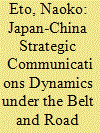

|
|
|
|
|
| Summary/Abstract |
Since the 2000s, the power of international narratives has attracted much attention in China. Under the Xi Jinping administration, the enhancement of "international discourse power" became an explicit policy and a diplomatic goal, closely linked to its Belt and Road Initiative (BRI). BRI, further, overlaps with China's efforts to develop a new concept of "institutional discourse power" as a mechanism to convert the economic gravity of China into political power by enhancing their agenda-setting capability, particularly in emerging rule-making process of the new economy. Such ambition has also shaped the new economic integrative framework between China and developed countries including Japan. Japan, on the other hand, relied on an increasingly inclusive notion of free and open Indo-Pacific (FOIP) to define and promote its relations with both "likeminded countries" and China for the purpose of making the BRI relative. Although Japan and China have agreed on economic cooperation in third countries as a new collaborative scheme in 2018, there remains a gap in their political objectives and strategic communications. This poses a major challenge for China, which hitherto has relied on China-centric narratives, as it can only enhance its identity as a global leading power by accommodating and accepting partially narratives of other major countries, including Indo-Pacific countries.
|
|
|
|
|
|
|
|
|
|
|
|
|
|
|
|
| 4 |
ID:
179941
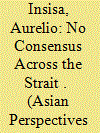

|
|
|
|
|
| Summary/Abstract |
After the 2016 elections, cross-Strait relations have fallen to their lowest point since the Third Strait Crisis. A proliferation of state-driven strategic narratives by both sides has since emerged. Against Beijing's narratives of "national rejuvenation," peaceful reunification, and "1992 Consensus," the Tsai administration has contraposed an image of Taiwan as a "beacon" of freedom and democracy in the Indo-Pacific. By tracing the tenets and the operationalization of Beijing and Taipei's strategic communications from the late 2000s to 2020, this article shows how Chinese and Taiwanese actors' reactions to the systemic pressure of a shifting East Asian regional order have progressively shaped cross-Strait communicative dynamics, severely constraining the range of options that could overcome the current impasse.
|
|
|
|
|
|
|
|
|
|
|
|
|
|
|
|
| 5 |
ID:
179946
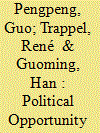

|
|
|
|
|
| Summary/Abstract |
How does "rightful resistance" take place in contemporary rural China? The continuously evolving village election system, the abolishment of the agricultural tax, and a new insistence on fighting corruption seemingly have created more space for the rural population in China to defend its rights. However, the central state's emphasis on solving the so-called three rural issues (sannong wenti 三农 问题)—raising incomes and welfare for the rural population, modernizing the countryside, and developing industrialized and modern agriculture—in a topdown manner and the continued use of "project-based management" have also greatly decreased the ability of the rural population to influence the agenda of the state and have thereby increased the potential for friction between the local state and its rural citizens. This article is a case study of a dispute between villagers and local cadres about the implementation of a reforestation project. While the case shows that villagers have several avenues for protest, it also hints at the low effectiveness of their protest and the continued existence of important structural obstacles dealing with different levels of the administration, including the atomization of villagers, the volatile nature of their interest coalition, and a profound lack of allies in society.
|
|
|
|
|
|
|
|
|
|
|
|
|
|
|
|
| 6 |
ID:
179940
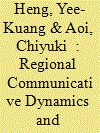

|
|
|
|
|
| Summary/Abstract |
Asian states are increasingly finding strategic communications to be an important tool of foreign and defense policy. Strategic communications involve coordinated messaging to achieve political objectives, utilizing words, actions, images, and various forms of signaling or symbols with the intention of influencing or persuading the target audiences. Such purposeful, coordinated, and targeted communications necessarily give rise to action-reaction dynamics that may have a tangible impact on interstate relations and the balance of power. How, then, do states in Asia employ such messaging activities in order to achieve influence? What dynamics are created by the employment of strategic communications by states in the region, and how do these affect intense greatpower rivalries and competition for leadership of international norms and in institutions in the region? The contributors to this special section address a series of common questions as the analytical framework for investigating how states conceptualize and utilize strategic communications to further national interests vis-à-vis their target states and domestic populace. The articles explore the communicative dynamics of strategic communications and how they impact perceptions of threat and the cost-benefit calculus associated with certain actions, such as escalation or de-escalation of tensions. This special section demonstrates the ways in which strategic communications are an integral element of an ongoing power transition in Asia and thus shape international relations in the region in critical ways.
|
|
|
|
|
|
|
|
|
|
|
|
|
|
|
|
| 7 |
ID:
179943
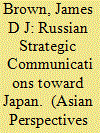

|
|
|
|
|
| Summary/Abstract |
Russia has been accused of weaponizing information to exert influence over the political systems and publics of countries in Europe and North America. However, is Moscow engaged in comparable activities in Japan? Given Japan's status as the United States' main ally in East Asia and the history of Soviet influence operations in the country, Japan is a logic target. Yet, to date, no detailed study has been conducted into Russia's use of information tools toward Japan. To fill this gap, in this article I examine Russia's contemporary strategic communications toward Japan in five areas: public diplomacy, Japanese mainstream media, Japanese social media, Russian state media in the Japanese language, and Russia's use of Japanese agents of influence. I also assess the extent to which these activities pose a threat to Japanese security by comparing Russia's activities via both a benign and malign model of strategic communications. This also facilitates comparisons with Russia's actions in other countries. Having identified contrasts in the approach taken by Russia toward Japan and Western states, the article concludes by discussing explanations for these differences.
|
|
|
|
|
|
|
|
|
|
|
|
|
|
|
|
|
|
|
|
|